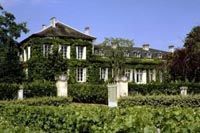 | The name Talbot appears on maps in the 18th Century, and despite what we know of his life, it is generally assumed that this refers to John Talbot. During the 18th and 19th Centuries the estate here was owned by the marquis d'Aux de Lescout, and was thus known as Talbot d'Aux. Under their tenure the wines fetched sufficiently high prices for classification of the estate as a quatrième cru in the 1855 classification. The Cordier family also acquired ownership of Lafaurie-Peyraguey and part of Gruaud-Larose, and although the latter has since been sold they retain control of Talbot today. The vineyards of Talbot dominate Saint Julien, in terms of size at least, as they account for an impressive 107 hectares. All the other chateaux, from the great second growths down to the cru bourgeois properties, dance around the periphery of the Talbot estate, which stretches over a huge swathe of the commune. |
| The soils underfoot are, as is typical, ancient quaternary gravels offering excellent drainage. Of the vineyard area, 102 ha are planted to red varieties, mostly Cabernet Sauvignon (66%), followed by Merlot (26%), Cabernet Franc (5%) and Petit Verdot (3%); there are also 5 hectares of Sauvignon Blanc and Semillon. They are Guyot trained, the norm in Bordeaux, average 35 years of age, and are harvested by hand with a final yield in the order of 45 hl/ha. It is then fermented according to plot of origin, using wooden vats or stainless steel, with temperature control. Those wines selected for the grand vin then go into oak, up to 60% new each year, before bottling as Chateau Talbot (30 000 cases per annum). The wines destined for the second wine, Connétable de Talbot, introduced in the 1970s, will typically see oak of which 20% is replaced each year. |  |